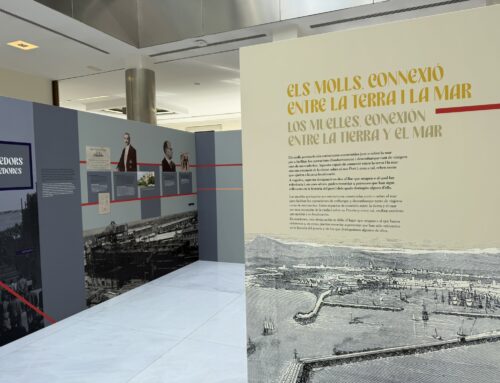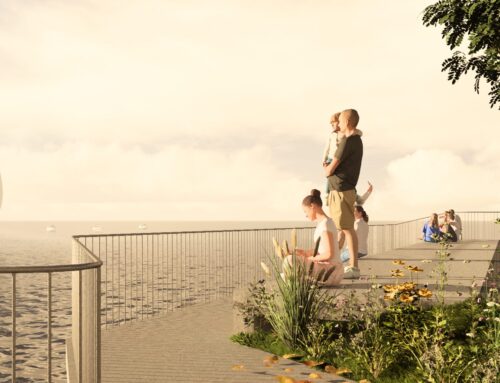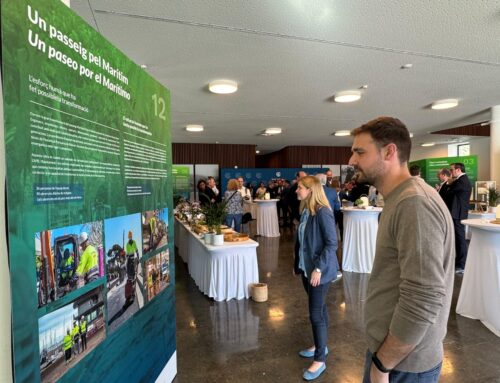The Port of Barcelona opens to the public the north and east zones of the Barcelona quay after relocating cruise and ferry operations to the Adossat quay. The Port provides Barcelona residents with a new 13,565 square meter space, bringing the sea closer to the city.
The Port of Barcelona makes an additional 13,565 square meters of surface area available to citizens in Port Vell by opening to the public the north and east zones of the Barcelona quay. This opening was formalized today as a preliminary step to the second Port of Barcelona Open Doors Days, which will take place this weekend and during which the new space will host a variety of activities for all ages, such as food trucks, children’s workshops and musical performances.
The open section of the Barcelona quay covers the area from the former Baleària terminal to the quay head—also opened—at the eastern end. A total of 13,565 square meters of surface area and 600 meters of quay line extend the freely accessible spaces of Port Vell for citizens and provide access to the sea within the World Trade Center complex, multiplying its appeal and energizing it.
The opening of the Barcelona quay follows the closure of the cruise terminal located in the north zone and the relocation of cruise and ferry operations to the Adossat quay, completed in autumn 2023. Earlier, the Baleària ferry operations had already been moved, allowing the Drassanes quay to be opened to the public last summer, just before the America’s Cup sailing competition. During the competition, the north zone of the Barcelona quay hosted the home base of the host team, Emirates Team New Zealand, as well as several of the event’s installations.
The area has now been refurbished for public use by leveling the pavement, installing street furniture and improving lighting, with an investment of over €100,000. This is an initial renovation, which will culminate in 2026 with a comprehensive repaving to urbanistically integrate the area around Port Vell and make it more accessible and attractive to the public.
This represents another step in the process of transforming and opening Port Vell to citizens undertaken by the Port of Barcelona, which in recent years has included the opening of the old Breakwater promenade, the Fishermen’s Quay with the new fish market, and the Drassanes quay, among others.
“The works we have carried out on the Drassanes quay and on the Barcelona quay—which now opens its quay wall to the public—provide an urban continuation of La Rambla, one of Barcelona’s main arteries, bringing it into Port Vell and all the way to the World Trade Center, one of its architectural and business hubs,” says José Alberto Carbonell, President of the Port of Barcelona.
The Mayor of Barcelona, Jaume Collboni, has thanked the Port of Barcelona for its sensitivity in reclaiming the quay for citizens. “Barcelona is a maritime city; the sea explains our DNA, our character and our economy. Our way of being in the world is inseparable from being a maritime city”. “We are working to recover and reconnect Barcelona with the port from every perspective, with the ambition that it be the people of Barcelona who lead this process.”
“The opening of more and better spaces for citizens has been the guiding thread of Port Vell’s transformation carried out in recent years, and the space we inaugurate today completes this process,” stated David Pino, Director of Port Vell. “With this new space we continue advancing to make Port Vell a more open area for Barcelona’s neighbours to enjoy,” he added.
The Barcelona quay was built in the 1870s as the first major southward extension of the Port of Barcelona. The rapid growth of international trade at the time soon required its enlargement, and it took its current form in the early 20th century. The central section housed warehouses and the passenger terminal for large ships bound for Italy and especially Latin America. In 1930 the Jaume I tower of the cable car linking Montjuïc with Port Vell was installed, and for much of the 20th century the Real Club Náutico and the Real Club Marítim de Barcelona were based here before moving to the Espanya quay. In the last decade of the 20th century, port activity shifted to the new southern quays, and the Barcelona quay was completely transformed to accommodate the World Trade Center, inaugurated in 1999, when it acquired its current configuration.





